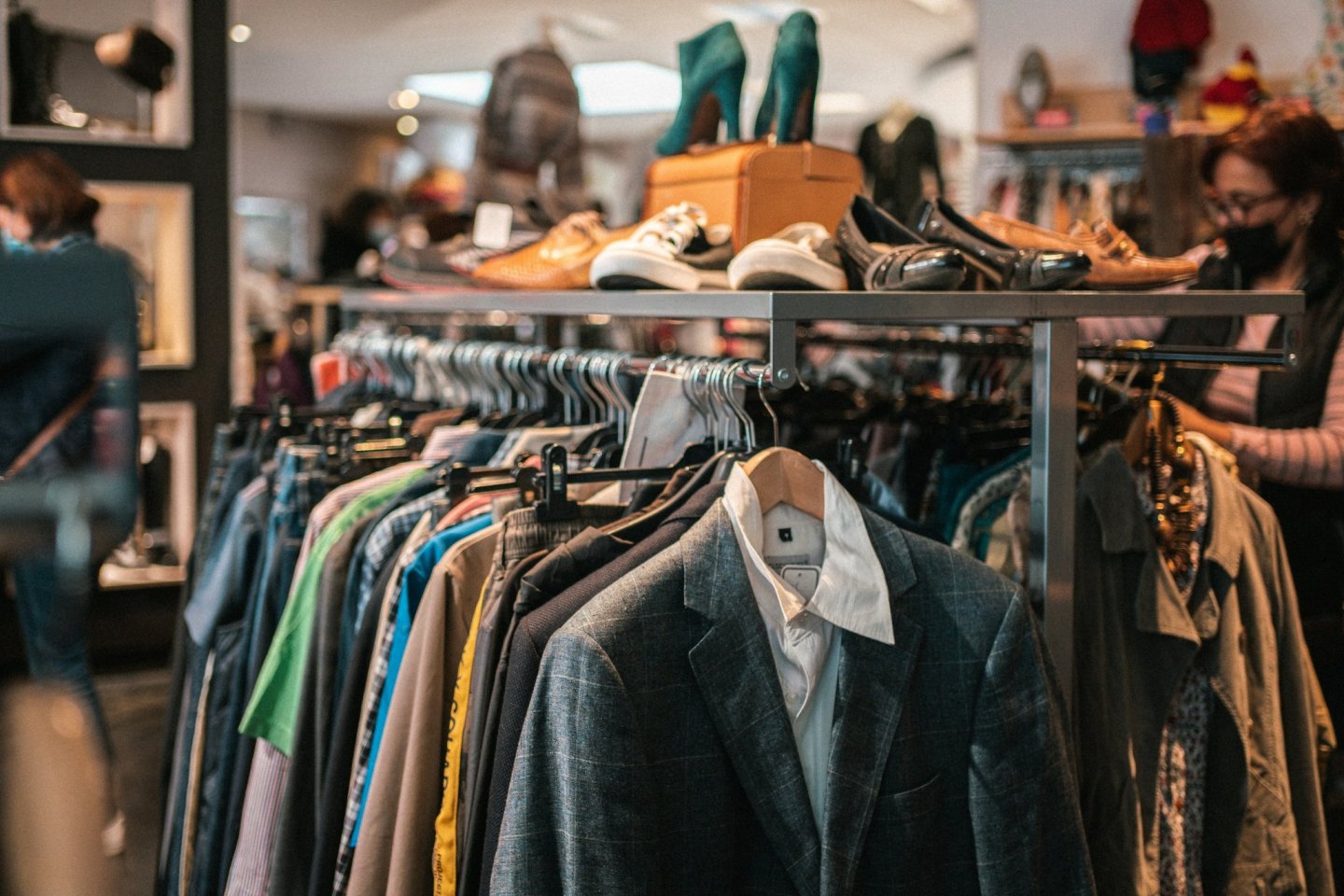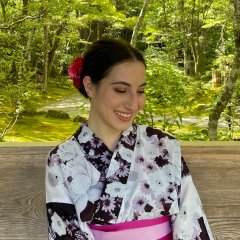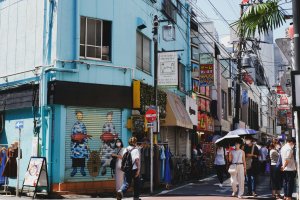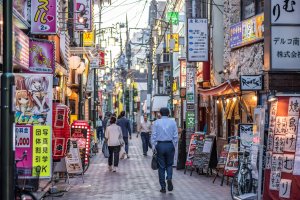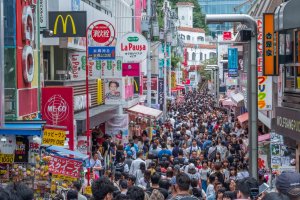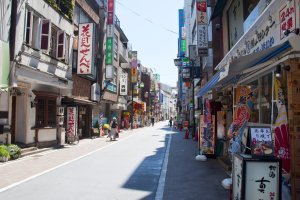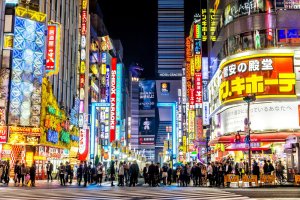If you are looking for some guidance to help elevate your thrift game in Tokyo, you have come to the right place!
Tokyo is a dynamic playground for fashion lovers—a place where high-end avenues lined with designer brands meet narrow alleyways packed with niche boutiques. Here, you will find an eclectic range of styles, from punk to goth to lolita to American and European vintage to timeless elegance. Unsurprisingly, this mix of mainstream and experimental fashion makes for an exciting thrifting experience. You never know what you will find!
In the guide below, we will introduce Tokyo’s most popular thrifting areas and chains, as well as relevant information about typical clothing styles, store locations, and pricing. Be sure to pack light! You are sure to have quite the thrift haul.
Tokyo’s best areas for thrifting
Shimokitazawa

An article about thrifting in Tokyo would be incomplete without mentioning the trendy neighborhood of Shimokitazawa. Located outside the busyness of central Tokyo, this laidback area is synonymous with vintage clothing stores, hip cafes, small independent shops, and live music venues. The neighborhood’s collection of small streets and alleys create an inviting place where creative people and those appreciative of the bohemian way of life gather. More than just a clothes thrifting hotspot, Shimokitazawa is a treasure trove of all things secondhand, including books, dishware, and vinyls.
- Don't miss: Stick Out, a used clothing and accessories store where everything costs ¥800!
- Location: Shimokitazawa is a neighborhood in Setagaya. Shimo-Kitazawa Station is about a three-minute train ride from Shibuya Station on the Inokashira Line and a 10-minute train ride from Shinjuku Station on the Odakyu Line.
Koenji

Koenji is an artsy hub where alternative music, discount shopping, bars, restaurants, and alternative youth culture thrive. In fact, Koenji has long served as a venue for punk rock music and is still home to numerous “live houses,” or live music clubs. This music scene, coupled with the area’s retro atmosphere, gives it an air of coolness. In terms of thrifting, the district features numerous shotengai (covered shopping streets) and alleys filled with unique vintage clothing stores.
- Don't miss: Hayatochiri, a store with a monster face facade that sells quirky and colorful fashion items, and Whistler, an American vintage store that specializes in clothes from the 1940s and 60s.
- Location: Koenji is a district in Suginami and is about a 10-minute train ride from Shinjuku Station on the JR Chuo-Sobu Line or JR Chuo Line.
Harajuku

Harajuku is one of Tokyo’s epicenters for youth fashion. The colorful and perpetually busy Takeshita Street is the heart of cosplay, anime, and kawaii (cute) culture and is lined with chic shops, secondhand clothes stores, Instagram-worthy foods (especially crepes), and quirky eateries. The nearby Cat Street, an alley that runs between Harajuku and the area around Shibuya Station, is also a notable destination abundant in fashion boutiques, secondhand clothing, cafes, and eateries. However, unlike the flamboyance of Takeshita Street, Cat Street has a more low-key atmosphere. Omotesando, a tree-lined avenue home to brand name stores, cafes, and restaurants, offers a more refined shopping experience for older visitors.
- Don't miss: BerBerJin, which is known for its vintage flannels, sweatshirts, jerseys, and denim.
- Location: Harajuku, located in Shibuya, is nestled between Shibuya and Shinjuku Station. Harajuku Station is a two-minute train ride from Shibuya Station and a four-minute train ride from Shinjuku Station on the JR Yamanote Line.
Kichijoji

Kichijoji is often hailed as one of Tokyo’s best places to live. This stylish neighborhood effortlessly balances urban life with nature. Here, you can unwind in the picturesque setting of Inokashira Park or explore the whimsical Ghibli Museum. For shopping and dining experiences, the area has no shortage of options, from shotengai (covered shopping streets) and vintage clothing stores to lantern-illuminated bars (Harmonica Yokocho Alley) and cozy cafes.
- Don't miss: Nico, a secondhand clothing shop open until 11pm that sells on-trend clothing from Europe and the US, and Amber Lion, a secondhand apparel store that sells American casual wear from the 1970s and 80s.
- Location: Kichijoji is a neighborhood in western Tokyo’s Mitaka City. Kichijoji Station is about an 18-minute train ride from Shibuya Station (Inokashira Line), a 15-minute train ride from Shinjuku Station (JR Chuo Line), and a 13-minute train ride from Shimokitazawa Station (Inokashira Line).
Shinjuku and Shibuya

We also want to give shoutouts to Shinjuku and Shibuya, both of which are extremely popular wards in Tokyo. Shibuya stands as the epicenter of modern Japanese culture and is a hub for fashionistas and creative types. In Shinjuku and Shibuya, the shopping and dining opportunities are endless, and at night, the areas’ come to life with their bars and nightclubs. Thanks to the wards’ constant happenings and mixing of cultures, you are bound to find some interesting shops!
- Location: Shibuya and Shinjuku are located directly next to each other and are slightly west of central Tokyo.
Popular thrift store chains in Tokyo
Below is a list of Tokyo’s most popular thrift store chains from least to most expensive. Please note that the pricing estimates are based on average prices store-wide for all products (clothes, accessories, shoes, etc.). Outliers may exist. For the purposes of this guide, prices are represented as follows.
- ¥ : cheap
- ¥¥ : medium
- ¥¥¥ : expensive
Of course, pricing is dependent on the quality of the goods and brands, so although some stores are ranked as “expensive,” the prices are still reasonable given the offerings.
Tanpopo House (¥)

Tanpopo House, founded in 1889, is renowned for its extremely cheap prices, with some items starting as low as ¥105! Each store has an assortment of approximately 20,000 items, including clothes, shoes, bags, and accessories for men, women, and children. Typically, the more expensive items are located near the cash register. Presently, the company has 12 stores in Tokyo, including branches in Shinjuku, Koenji, and Ueno (Taito).
MODE-OFF (¥)

MODE-OFF is an apparel brand from the HARD-OFF Group, a company that focuses on selling recycled and secondhand goods—from furniture and other house-related items (HOUSE-OFF) to liquor (LIQUOR-OFF) to electronics and instruments (HARD-OFF). MODE-OFF is known for its inexpensive clothing, bags, shoes, and accessories for men and women. The store is less focused on trend-driven items and more so aims to sell things for cheap. MODE-OFF has locations in Kichijoji, Koenji, and Ueno (Taito), among others.
BAZZSTORE (¥ ~ ¥¥)

BAZZSTORE offers a wide range of domestic and foreign brands, as well as non-brand fashion goods, including clothing, bags, watches, shoes, and accessories. Most items fall within the ¥1,000 to ¥5,000 range. However, popular brands can be more pricey. Given its mix of used clothing, BAZZSTORE is a great place for thrifters to find inexpensive deals and affordably priced brands. BAZZSTORE has 14 stores in Tokyo, with some branches in Shimokitazawa, Harajuku, Koenji, and Ikebukuro.
KINJI (¥ ~ ¥¥)

KINJI is a beloved thrift store popular for its huge selection of trendy items, including contemporary and vintage clothes, accessories, and bags. Prices are reasonable and generally between ¥2,000 and ¥5,000. Though sometimes you can find pieces for as low as a couple hundred yen! KINJI has two locations in Harajuku and one in Shimokitazawa.
NEW YORK JOE EXCHANGE (¥¥)

NEW YORK JOE EXCHANGE sells imported (primarily American and European) and domestic secondhand clothing, including branded and non-branded items. Most products in the store are less than ¥10,000, with the average price being between ¥2,000 and ¥3,000. Also, all items are 50% off every first Sunday of the month! NEW YORK JOE EXCHANGE has locations in Shimokitazawa, Kichijoji, and Shibuya.
TreFacStyle (¥¥)

TreFacStyle, short for Treasure Factory Style, is a fashion brand of Treasure Factory, a general recycling shop that sells a variety of goods, including home appliances, outdoorsy items, musical instruments, and more. TreFacStyle offers a wide mix of contemporary designer and non-designer clothing, accessories, and handbags. Most goods are priced between ¥4,000 and ¥9,000. Brand name items can be more expensive and non-designer items can be as low as ¥1,000 to ¥2,000. TreFacStyle has over 40 stores in Tokyo, including popular branches in Kichijoji, Koenji, and Shimokitazawa.
2nd STREET (¥¥)

2nd STREET is one of Japan’s largest secondhand chains, with more than 800 stores nationwide, and sells a mix of Japanese brands, foreign brands, and non-branded items. Here, you can find everything from high quality designer brands to vintage items to trendy clothes, shoes, and accessories. Expect prices between ¥4,000 and ¥10,000. 2nd STREET has nine different store types, three of which focus on fashion—Apparel Reuse (fashion items at affordable prices), Used Select (carefully-selected fashion items, mainly brand names), and Brand Speciality Store (luxury brands). 2nd STREET has over 70 stores in Tokyo Prefecture, including locations in Shimokitazawa, Kichijoji, Koenji, Shibuya, Shinjuku, Harajuku, and Ikebukuro.
Chicago (¥¥)

Chicago offers an intriguing blend of Japanese, American, and European clothing and related goods at reasonable prices. One of Chicago’s most unique points is its collection of secondhand kimono, yukata (summer kimono), and kimono accessories. Chicago has three stores in Harajuku, one in Shimokitazawa, and one in Kichijoji.
JAM (¥¥)

JAM sells a wide range of high quality vintage fashion, including brand names such as Levi’s, Dr. Martens, and Ralph Lauren. The store is known for keeping up with current fashion trends, and prices typically range from ¥4,000 to ¥11,000. There are a number of brand items priced outside this range as well. JAM has stores in Shimokitazawa, Harajuku, and Shibuya (Meiji Dori).
Flamingo (¥¥)

Visually characterized by the neon-lit flamingos by its entrance, Flamingo is a popular American vintage clothes store. In fact, the majority of the store’s stock is imported from the US (and sometimes Europe). Available items include women’s and men’s clothing, as well as accessories. The store focuses on clothing from the 1950s to 90s, giving it old school Americana vibes. Most items are priced between ¥3,000 and ¥7,000. Flamingo has stores in Omotesando (Shibuya), Harajuku, Kichijoji, and Shimokitazawa.
RagTag (¥¥ ~ ¥¥¥)

RagTag specializes in secondhand designer clothing, handbags, shoes, accessories, and more. Here, you can peruse brands such as HERMES, CHANEL, LOUIS VUITTON, GUCCI, PRADA, and more for discounted amounts. A large portion of RagTag’s items fall within the ¥1,000 to ¥30,000 range. However, high-end brands can be priced much higher. RagTag has locations in Shibuya, Shinjuku, Shimokitazawa, Harajuku, Kichijoji, and Ginza.
KOMEHYO (¥¥¥)

Similar to RagTag, KOMEHYO sells carefully selected designer clothing, bags, jewelry, watches, and more for reduced prices. However, given the high status brands, the prices can still be quite expensive. KOMEHYO’s most popular branches are located in Shinjuku, Shibuya, Ginza, and Aoyama (Minato).
Happy thrifting!
Of course, this guide is far from exhaustive as Tokyo has plenty of other areas and shops where you can find secondhand clothing and fashion items. As a bonus, we also recommend researching if there will be any flea markets held during your visit.
Have fun, and embrace your creative eye in Tokyo!
